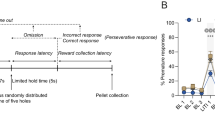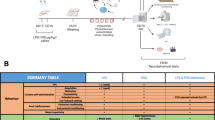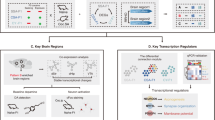Abstract
Impulsivity shares high comorbidity with substance abuse in humans, and high impulsivity (HI) in rats has been identified as a predictive factor for cocaine addiction-like behavior. Despite the evidence that high impulsivity is associated with altered function of corticostriatal networks, the specific neural substrates underlying the increased vulnerability of impulsive individuals to develop cocaine addiction remain unknown. We therefore investigated specific neural correlates of HI within the corticostriatal circuitry and determined how they interact with a protracted history of cocaine self-administration. We used in situ hybridization to map brain expression of two major genes implicated in impulsivity, encoding the dopamine D2 receptor (DA D2R) and the 5-HT2c receptor (5-HT2cR), and an immediate early gene associated with neuronal plasticity, zif268, in groups of rats selected for HI and low impulsivity (LI) on a 5-choice serial reaction time task (5-CSRTT) immediately after 5-CSRTT training, and following 10 or 50 days of cocaine self-administration. HI rats exhibited decreased DA D2R mRNA in the mesolimbic pathway, and increased 5-HT2cR mRNA in the orbitofrontal cortex compared with LI rats. HI rats also showed decreased zif268 mRNA in the ventral and dorsomedial striatum. Cocaine exposure decreased striatal D2R mRNA in both HI and LI rats, decreased 5-HT2cR mRNA differentially in striatal and prefrontal areas between HI and LI rats, and selectively decreased zif268 mRNA in the orbitofrontal and infralimbic cortices of HI animals. These findings implicate novel markers underlying the vulnerability of impulsive rats to cocaine addiction that localize to the OFC, infralimbic cortex, and striatum.
Similar content being viewed by others
Log in or create a free account to read this content
Gain free access to this article, as well as selected content from this journal and more on nature.com
or
References
Bath RV, Baraban JN (1993). Activation of transcription factor genes in striatum by cocaine: role of both serotonin and dopamine systems. J Pharmacol ExpTher 267: 496–505.
Belin D, Balado E, Piazza PV, Deroche-Gamonet V (2009). Pattern of intake and drug craving predict the development of cocaine addiction-like behavior in rats. Biol Psychiatry 65: 863–868.
Belin D, Berson N, Balado E, Piazza PV, Deroche-Gamonet V (2011). High-novelty-preference rats are predisposed to compulsive cocaine self-administration. Neuropsychopharmacology 36: 569–579.
Belin D, Deroche-Gamonet V, Jaber M (2007). Cocaine-induced sensitization is associated with altered dynamics of transcriptional responses of the dopamine transporter, tyrosine hydroxylase, and dopamine D2 receptors in C57Bl/6J mice. Psychopharmacology (Berl) 193: 567–578.
Belin D, Everitt BJ (2008). Cocaine seeking habits depend upon dopamine-dependent serial connectivity linking the ventral with the dorsal striatum. Neuron 57: 432–441.
Belin D, Mar AC, Dalley JW, Robbins TW, Everitt BJ (2008). High impulsivity predicts the switch to compulsive cocaine-taking. Science 320: 1352–1355.
Berg KA, Clarke WP, Cunningham KA, Spampinato U (2008). Fine-tuning serotonin2c receptor function in the brain: molecular and functional implications. Neuropharmacology 55: 969–976.
Besson M, Belin D, McNamara R, Theobald DE, Castel A, Beckett VL et al (2010). Dissociable control of impulsivity in rats by dopamine D2/3 receptors in the core and shell subregions of the nucleus accumbens. Neuropsychopharmacology 35: 560–569.
Boulougouris V, Robbins TW (2010). Enhancement of spatial reversal learning by 5-HT2C receptor antagonism is neuroanatomically specific. J Neurosci 30: 930–938.
Bubar MJ, Cunningham KA (2008). Prospects for serotonin 5-HT2R pharmacotherapy in psychostimulant abuse. Prog Brain Res 72: 319–346.
Buckholtz JW, Treadway MT, Cowan RL, Neil D, Woodward ND, Li R et al (2010). Dopaminergic network differences in human impulsivity. Science 329: 532.
Clarke HF, Walker SC, Dalley JW, Robbins TW, Roberts AC (2007). Cognitive inflexibility after prefrontal serotonin depletion is behaviorally and neurochemically specific. Cereb Cortex 17: 18–27.
Clemett DA, Punhani T, Duxon MS, Blackburn TP, Fone KC (2000). Immuno-histochemical localisation of the 5-HT2c receptor protein in the rat CNS. Neuropharmacology 39: 123–132.
Dalley JW, Everitt BJ, Robbins TW (2011). Impulsivity, compulsivity, and top-down cognitive control. Neuron 69: 680–694.
Dalley JW, Fryer TD, Brichard L, Robinson ES, Theobald DE, Lääne K et al (2007). Nucleus accumbens D2/3 receptors predict trait impulsivity and cocaine reinforcement. Science 315: 1267–1270.
Dalley JW, Roiser JP (2012). Dopamine, serotonin and impulsivity. Neuroscience 215: 42–58.
Deroche-Gamonet V, Belin D, Piazza PV (2004). Evidence for addiction-like behavior in the rat. Science 305: 951–953.
Di Matteo V, Cacchio M, Di Giulio C, Esposito E (2002). Role of serotonin(2C) receptors in the control of brain dopaminergic function. Pharmacol Biochem Behav 71: 727–734.
Diergaarde L, Pattij T, Poortvliet I, Hogenboom F, de Vries W, Schoffelmeer AN et al (2008). Impulsive choice and impulsive action predict vulnerability to distinct stages of nicotine seeking in rats.. Biol Psychiatry 63: 301–308.
Eagle DM, Baunez C (2010). Is there an inhibitory-response-control system in the rat? Evidence from anatomical and pharmacological studies of behavioral inhibition. Neurosci Biobehav Rev 34: 50–72.
Economidou D, Pelloux Y, Robbins TW, Dalley JW, Everitt BJ (2008). High impulsivity predicts relapse to cocaine-seeking after punishment-induced abstinence. Biol Psychiatry 65: 851–856.
Ersche KD, Barnes A, Jones PS, Morein-Zamir S, Robbins TW, Bullmore ET (2011). Abnormal structure of frontostriatal brain systems is associated with aspects of impulsivity and compulsivity in cocaine dependence. Brain 134: 2013–2024.
Everitt BJ, Belin D, Economidou D, Pelloux Y, Dalley JW, Robbins TW (2008). Neural mechanisms underlying the vulnerability to develop compulsive drug-seeking habits and addiction. Philos Trans R Soc Ser B 363: 3125–3135.
Everitt BJ, Hutcheson D, Ersche KD, Pelloux Y, Dalley JW, Robbins TW (2007). The orbital prefrontal cortex and drug addiction in laboratory animals and humans. Ann NY Acad Sci 1121: 576–597.
Filip M, Alenina N, Bader M, Przegaliński E (2010). Behavioral evidence for the significance of serotoninergic (5-HT) receptors in cocaine addiction. Addict Biol 15: 227–249.
Fumagalli F, Franchi C, Caffino L, Racagni G, Riva MA, Cervo L (2009). Single session of cocaine intravenous self-administration shapes goal-oriented behaviors and up-regulates Arc mRNA levels in rat medial prefrontal cortex. Int J Neuropsychopharmacol 12: 423–429.
Harrison AA, Everitt BJ, Robbins TW (1997). Central 5-HT depletion enhances impulsive responding without affecting the accuracy of attentional performance: interactions with dopaminergic mechanisms. Psychopharmacology (Berl) 133: 329–342.
Hearing MC, See RE, McGinty JF (2008). Relapse to cocaine-seeking increases activity-regulated gene expression differentially in the striatum and cerebral cortex of rats following short or long periods of abstinence. Brain Struct Funct 213: 215–227.
Higgins GA, Fletcher PJ (2003). Serotonin and drug reward: focus on 5-HT2C receptors. Eur J Pharmacol 480: 151–162.
Hope B, Kosofsky B, Hyman SE, Nestler EJ (1992). Regulation of immediate early gene expression and AP-1 binding in the rat nucleus accumbens by chronic cocaine. Proc Natl Acad Sci USA 89: 5764–5768.
Kasanetz F, Deroche-Gamonet V, Berson N, Balado E, Lafourcade M, Manzoni O et al (2010). Transition to addiction is associated with a persistent impairment in synaptic plasticity. Science 328: 1709–1712.
Kasanetz F, Lafourcade M, Deroche-Gamonet V, Revest JM, Berson N, Balado E et al (2012). Prefrontal synaptic markers of cocaine addiction-like behavior in rats. Mol Psychiatry (E-pub ahead of print).
Knapska E, Kaczmarek L (2004). A gene for neuronal plasticity in the mammalian brain: Zif268/Egr-1/NGFI-A/Krox-24/TIS8/ZENK? Prog Neurobiol 74: 183–211.
Lee B, London ED, Poldrack RA, Farahi J, Nacca A, Monterosso JR et al (2009). Striatal dopamine D2/D3 receptor availability is reduced in methamphetamine dependence and is linked to impulsivity. J Neurosci 29: 14734–14740.
Lee SS, Humphreys KL, Flory K, Liu R, Glass K (2011). Prospective association of childhood attention-deficit/hyperactivity disorder (ADHD) and substance use and abuse/dependence: a meta-analytic review. Clin Psychol Rev 3: 328–341.
Millan EZ, Marchant NJ, McNally GP (2011). Extinction of drug seeking. Behav Brain Res 217: 454–462.
Nader MA, Morgan D, Gage HD, Nader SH, Calhoun TL, Buchheimer N et al (2006). PET imaging of dopamine D2 receptors during chronic cocaine self-administration in monkeys. Nat Neurosci 9: 1050–1056.
Navailles S, Moison D, Ryczko D, Spampinato U (2006). Region-dependent regulation of mesoaccumbens dopamine neurons in vivo by the constitutive activity of central serotonin2C receptors. J Neurochem 99: 1311–1319.
Oades RD (2008). Dopamine–serotonin interactions in attention-deficit hyperactivity disorder (ADHD). Prog Brain Res 172: 543–565.
Pelloux Y, Everitt BJ, Dickinson A (2007). Compulsive drug seeking by rats under punishment: effects of drug taking history. Psychopharmacology (Berl) 194: 127–137.
Peters J, LaLumiere RT, Kalivas PW (2008). Infralimbic prefrontal cortex is responsible for inhibiting cocaine seeking in extinguished rats. J Neurosci 28: 6046–6053.
Porrino LJ, Daunais JB, Smith HR, Nader MA. (2004). The expanding effects of cocaine: studies in a nonhuman primate model of cocaine self-administration. Neurosci Biobehav Rev 27: 813–820.
Robbins TW (2002). The 5-choice serial reaction time task: behavioural pharmacology and functional neurochemistry (2002). Psychopharmacology (Berl) 163: 362–380.
Robinson ES, Dalley JW, Theobald DE, Glennon JC, Pezze MA, Murphy ER et al (2008). Opposing roles for 5-HT2A and 5-HT2C receptors in the nucleus accumbens on inhibitory response control in the 5-choice serial reaction time task. Neuropsychopharmacology 33: 2398–2406.
Schilman EA, Klavir O, Winter C, Sohr R, Joel D (2010). The role of the striatum in compulsive behavior in intact and orbitofrontal-cortex-lesioned rats: Possible involvement of the serotonergic system. Neuropsychopharmacology 35: 1025–1039.
Schoenbaum G, Shaham Y (2008). The role of orbitofrontal cortex in drug addiction: a review of preclinical studies. Biol Psychiatry 63: 256–262.
Unal CT, Beverley JA, Willuhn I, Steiner H (2009). Long-lasting dysregulation of gene expression in corticostriatal circuits after repeated cocaine treatment in adult rats: effects on zif 268 and homer 1a. Eur J Neuroci 29: 1615–1626.
Valjent E, Aubier B, Corbillé AG, Brami-Cherrier K, Caboche J, Topilko P et al (2006). Plasticity-associated gene Krox24/Zif268 is required for long-lasting behavioral effects of cocaine. J Neurosci 26: 4956–4960.
Vanderschuren LJ, Everitt BJ (2004). Drug seeking becomes compulsive after prolonged cocaine self-administration. Science 305: 1017–1019.
Verdejo-Garcia A, Lawrence JA, Clark L (2008). Impulsivity as a vulnerability marker for substance-use disorders: review of findings from high-risk research, problem gamblers and genetic association studies. Neurosci Biobehav Res 32: 777–810.
Viggiano D, Ruocco LA, Sadile AG (2003). Dopamine phenotype and behaviour in animal models: in relation to attention deficit hyperactivity disorder. Neurosci Biobehav Rev 27: 623–637.
Volkow ND, Fowler JS, Wang GJ, Swanson JM. (2004). Dopamine in drug abuse and addiction: results from imaging studies and treatment implications. Mol Psychiatry 9: 557–569.
Xu X, Brookes K, Sun B, Ilott N, Asherson P (2009). Investigation of the serotonin 2C receptor gene in attention deficit hyperactivity disorder in UK samples. BMC Res Notes 2: 71.
Acknowledgements
This study was supported by the MRC (G9536855, G1002231 and G0701500) and by a joint core award from the MRC and Wellcome Trust (MRC G1000183; WT 093875/Z/10/Z) in support of the Behavioural and Clinical Neuroscience Institute at Cambridge University. MB was supported by an EMBO fellowship. DB and ABR were supported by an INSERM AVENIR Grant, the AXA research fund, the fondation pour la recherche médicale (FRM), and the IREB. AL was supported by a Wellcome Trust Programme Grant (089589/Z/09/Z). We thank Mercedes Arroyo for technical assistance with the in situ hybridization experiments.
Author information
Authors and Affiliations
Corresponding author
Ethics declarations
Competing interests
The authors declare no conflict of interest.
Additional information
Supplementary Information accompanies the paper on the Neuropsychopharmacology website
Supplementary information
Rights and permissions
About this article
Cite this article
Besson, M., Pelloux, Y., Dilleen, R. et al. Cocaine Modulation of Frontostriatal Expression of Zif268, D2, and 5-HT2c Receptors in High and Low Impulsive Rats. Neuropsychopharmacol 38, 1963–1973 (2013). https://doi.org/10.1038/npp.2013.95
Received:
Revised:
Accepted:
Published:
Issue date:
DOI: https://doi.org/10.1038/npp.2013.95
Keywords
This article is cited by
-
Cell-type specific synaptic plasticity in dorsal striatum is associated with punishment-resistance compulsive-like cocaine self-administration in mice
Neuropsychopharmacology (2023)
-
Effects of quinpirole in the ventral tegmental area on impulsive behaviour during performance on the five-choice serial reaction time task
Experimental Brain Research (2023)
-
Convergent neural connectivity in motor impulsivity and high-fat food binge-like eating in male Sprague-Dawley rats
Neuropsychopharmacology (2019)
-
Withdrawal from escalated cocaine self-administration impairs reversal learning by disrupting the effects of negative feedback on reward exploitation: a behavioral and computational analysis
Neuropsychopharmacology (2019)
-
Fractionating impulsivity: neuropsychiatric implications
Nature Reviews Neuroscience (2017)



